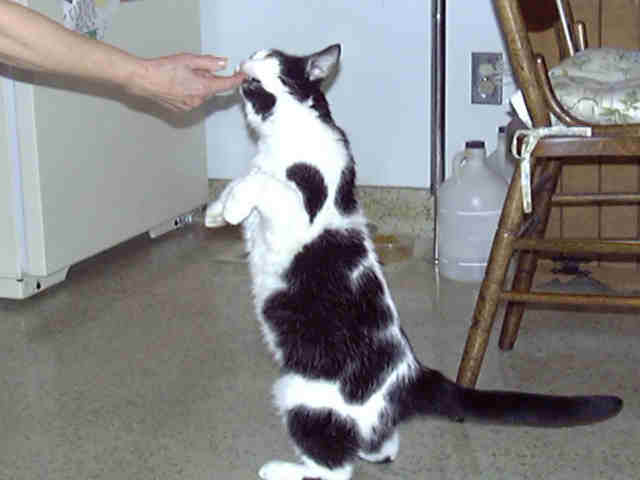An Explanation of
why Dogs and Cats
have Fleas
|
|

Understanding and Coping with Fleas
By Dan Becker
My Dog has Fleas
We have all seen them and felt them. We have watched our pets
suffer from them. We've cursed them. We have spent tons of money
to get professionals to fumigate our homes and we've even
threatened to burn down our homes to get rid of them, and in the
end all anyone can do is stand back and say When I die the first
question I'm going to ask God is "What good are fleas?"
Well, I'm not God, and I have yet to find out what good fleas do
in the universe, but maybe this article will help you to
understand fleas, and through that understanding be able to cope
with them better.
There are more than 2,000 known species of fleas, but for the
purpose of this discussion I will limit myself to the Dog Flea,
(Ctenocephalides canis) and the Cat Flea (Ctenocephalides felis).
These names are misleading: cat fleas live on dogs, too, and in
fact, the dog flea is actually less of a problem in the US than
the cat flea. The dog flea occurs in the moist climates and is
problem to dogs and rabbits in these areas but is rarely found on
cats.
The cat flea, on the other hand, can live on cats and dogs all
year long, but is most prevalent during the hot summer months.
Other host animals include opossums, foxes, mongooses, and rats.
As many of us know they also eagerly attack and feed on humans.
During the last twenty years fleas have become more of a problem.
The most notable reasons for this are that we no longer use
Chlordane as a general-use lawn pesticide, and with the use of
man-made fibers for carpeting, the use of hydrocarbons for
mothproofing has all but ceased. Hydrocarbons were long-lasting
and kept pests of all kinds in control.
Development and habits of fleas
Fleas go through a complete metamorphosis, which means they go
through four stages of life.
Egg Stage: The adult female lays a single, oval egg on your pet.
Since the egg is not fastened, it can fall off, usually, but not
always, in the pet's sleeping area. You may find eggs on the
pet's bedding, in floor crevices, and around the edge of
carpeting where dirt and lint collect. An egg is about the size
of a pin head. A warm, humid place provides the most favorable
conditions for hatching.
Larval Stage: If the relative humidity is 50%, the egg will hatch
in about 10 days. If the humidity is as high as 90%, it will
hatch in about 5 days. The small, white, eyeless, legless,
maggot-like larvae can wriggle and move around. The larvae, which
are slightly smaller than a grain of rice, live on the organic
matter in their environment, the stuff we leave when we clean and
vacuum our homes and our pets' bedding. The larval stage usually
lasts 7-15 days, but can last for several months if the
environmental conditions are not right for further development to
occur.
Pupa Stage: towards the end of the Larval stage the larva wraps
itself in a cocoon of small pieces of debris and organic
sediment. This will hide the cocoon in its natural surroundings.
This stage typically lasts 7-10 days, but can last as long as 20
weeks, again depending on conditions, after which the adult flea
emerges.
Adult Stage: The adult flea has substantial body reserves and can
live for months without feeding if there are no hosts available.
But once a host becomes available the flea will start feeding
immediately. And flea bits itch. Most people with pets have seen
the constant chewing and scratching that, in the worst cases,
results in large, raw, bleeding areas on the side or underside of
the pet. Adult fleas live anywhere from a few days to several
months. As we all know from experience, they are most prevalent
in late summer into fall.
Fleas and diseases
In the Middle Ages Bubonic Plague--spread by rats infected by
fleas--killed tens of millions of people. It is now estimated
that 10 million people have died of plague in the last 100 years.
Most of these deaths have occurred in Asia, but a few still occur
in the US. More common, though, in the United States, is Murine
Typhus, which is also spread to humans by way of rodents infected
by fleas. This disease is most common to the Gulf states and the
southwest but is said to be spreading northward.
Flea control
There are no guaranteed methods of ridding your home and pets of
fleas. There are ways, however, to make your life and your pet's
life more bearable.
Vacuuming is the first and most important step to flea control.
Vacuum all carpeted areas and all upholstered furniture. Don't
forget to remove all pillows and cushions and vacuum them also.
As you vacuum pay very close attention to the areas around your
baseboards, the corners, and around and under all furniture. Once
you have done this, remove the vacuum bag immediately and get it
out of the house. Then vacuum again, and again remove the bag. In
some cases the vacuum bag can provide a breeding ground, and
fleas can escape back through the hose and back into your house.
The next step is to scrub all non-carpeted areas where your pet
may rest. This includes window sills, head boards, tiled floors,
appliance tops and cement floors and patios. A hot, soapy water
solution is best. You may also add some bleach to this solution.
DO NOT MIX BLEACH AND AMMONIA.
While you are destroying your home you should take your pet to
your veterinarian or groomer to be flea-dipped. If you don't do
this at the same time all of your time and money will be wasted.
Remember that doing this once will probably not be enough. You
should follow this routine at least monthly during severe
infestations. There is no cure-all, but through regular
maintenance your life, and the life of your pet will be much more
enjoyable and healthy.
If your problem is out of control even after all of these
efforts--and that perception is different with everybody--then
you need the help of a reliable, professional pest control
company. Follow their advice to the letter.
In addition to the above you can treat your pet medically. One
treatment involves giving your pet a pill once a month. When your
pet is bitten by a female flea the active ingredient is ingested
and passed into the eggs which are then killed, thus breaking the
life cycle of the flea. An alternative treatment involves rubbing
a liquid into your pet's fur and down to the skin level. The
active ingredient causes the nervous system of the flea to fail
thus causing the flea to die. In either case it is necessary to
consult your veterinarian and he or she can help you decide which
system is best for you and your pet.
THANKS
Dan Becker

Tippy and Alfred's Flea Story
The winter before we started eating the Life's Abundance food and taking
the Daily Supplement, we had a lot of fleas.
Our human friends set off bombs and vacuumed the carpets all the time
trying to get rid of those darn pesky creatures. Plus they had us on this
really toxic stuff called Advantage. Man was it wicked....it worked for a
little while but never got rid of the fleas, they always came back.
And all Dave did was gripe about how expensive it was.
It was embarrassing for them because when company would come over, fleas
would jump up on their legs.
Dave & Jan's social life wasn't too pleasant at that time.
The next fall, they put us on the food and Daily Supplement. That winter,
Dave & Jan did not set off one single flea bomb and did not use the
Advantage.
There simply wasn't a flea problem!
That totally amazed our human friends so they asked Dr. Jane Bicks why this
happened.
She said the Life's Abundance food and Daily Supplement gave us the
nutrition we needed to build a strong, healthy immune system and because our
systems were now a lot stronger....it actually repelled the fleas!
Whatever happened...we just know it worked!
so do your precious furry friend a big favor and try the Daily Nutritional
System out....
You've got nothing to lose....except those darn pesky fleas.......
 Tippy & Alfred's
Choice of Dining Experience Here
Tippy & Alfred's
Choice of Dining Experience Here

More Pet Care Tips
|